Match Services
-
- There’s an App for That! Marine Technology, Mar 2014 #38
Protect your unmanned investment, operate multiple systems, mix and match services Plug-and-play capabilities for unmanned systems?
Scientists have long recognized the value of unmanned systems as tools to conduct exploration and research. The advantages are many, and the cost is usually less than would be incurred for a research ship or manned aircraft mission.
Original equipment manufacturers (OEMs) who make unmanned underwater vehicles (UUVs), unmanned surface vehicles (USVs), and unmanned aerial vehicles (UAVs) usually provide the vehicle, control station, software and communication protocols, which are almost always unique to that system.
As technology and the market mature, there is a growing demand for flexibility to adapt systems for different missions, operate different systems from a common control station and upgrade them easily when new and innovative applications become available.
While the armed forces are leading the way, commercial, academic, homeland security, law enforcement and other users of unmanned systems can benefit, too.
“We’ve standardized the means of controlling and communicating between the ground and the bird and all of the systems involved. The standard that we’re working on is called the Unmanned Aircraft Systems (UAS) Control Segment, or UCS, and it is hardware independent,” said Rich Ernst, who leads the USC architecture development in DoD.”
All systems do not necessarily use the same functions, but with many systems you have to accept what functions the OEM provides. Some are simple, and others complex. Some systems give you more than you really need, and some not quite enough. With UCS, you can now mix and match applications, using only what you need, and you can take advantage of new applications as they become available.
“We can identify specific requirements and create applications that meets that requirement, or closes the gap,” said Ernst.
“We’ve been limited by the fact that OEMs have different approaches with different hardware, software, processes and interfaces—different everything,” said Ernst. “That’s what we’re trying to avoid.”
“UCS ensures that the interface standard is known to all vendors so we don’t have proprietary interface standards where only the OEM can add or subtract to it without significant cost growth,” said Lt. Col. James Kennedy, Product Manager Common Systems Integration with the Unmanned Aircraft Project Office, PEO Aviation at Redstone Arsenal, Alabama. “We typically end up having to go back to the same vendor who wrote the software initially to add capability. UCS repackages that software into an open standard that is well-known, that isn’t commercialized, that industry recognizes and thereby opens our competition and it opens the ability for third parties to add capability.”
“Our vision is an architecture that is flexible enough to range from our small UAS and OSRVT (One System Remote Video Terminal), through our large UAS and the ground control station,” said Kennedy.
According to Ernst, UCS breaks up the different ground control segment functionalities, which allows for insertion of new capabilities and upgrading of legacy capabilities—such as route planning, weather services, task monitoring or flight status monitoring that most GCS have to implement—without having to rebuild the entire GCS. “It’s ‘plug and play’ for GCS development.”
Legacy systems can be adapted for UCS, and are then able to take advantage of the many benefits of UCS. This helps to protect an investment in a system, and can prolong the service life of the system by adding new capability.
The software from the Army Bi-Directional Remote Video Transceiver (BDRVT), which is an enhanced version of the Army’s One System Remote Video Transceiver (OSRVT) (made by AAI Corporation to support video and telemetry from a number of UAS such as Shadow, Predator, Pioneer and others), was used to demonstrate how UCS works.
One experiment was conducted by the Navy. “BDRVT was totally integrated software,” said Wayne Perras, UCS project manager at the Office of Naval Research (ONR). “We broke it up into services and rewrote those services into UCS in two different codes. Then we combined the services back together again to see if we can have that same BDRVT to prove that that it operates vehicles.”
“We showed that we’ve got interoperability by having it built and written in a different code, and being able to exchange or replace services while continuing to operate at the same performance,” Perras said.
Then the Army flight-tested the UCS-compliant BDRVT with an AAI Corporation Shadow reconnaissance UAS.
“We took a bidirectional capability, put it into an open architecture model which was compliant with the UCS standards and demonstrated that the open model could, in fact, address the bidirectional capability that we’re looking to put into our systems,” said Kennedy.
The flight-test using an Army Shadow UAS was a success. “It was so successful that we have moved our whole OSRVT architecture to be compliant with those open standards,” Kennedy said. “This allows us to more readily connect the applications that third parties may have developed, whether it’s Garmin or third-party contractor developed applications that plug into our known standard, thereby reducing the cost of integration for the program overall. It also allows us to introduce competition into the program, because now we don’t have to keep going back to the same vendor in order to add capabilities. We can compete and allow other vendors to be able to develop those applications—as long as they’re applying those standards that are embedded due to UCS and open architecture—so the integration cost is less. So it was a very successful demo and it’s caused us to really focus our OSRVT around that open architecture standard.”
“Legacy GCS systems can naturally transition to using the UCS architecture. This simplifies the integration of legacy systems, since, in large part, UCS was designed from the ground up to ensure that the needs of legacy systems were analyzed and incorporated,” Ernst said.
Adapting existing software incurs a cost, but that cost can have a significant return on investment.
Ernst said that there are many industry best practices for developing modular software. UCS has chosen a “functional decomposition,” which breaks apart GCS capabilities based on common functions (e.g. route planning, weather monitoring, task monitoring, flight status monitoring, etc.) that most GCS have to implement.
This is benefiting the Navy today as it develops the UCS-based common control system (CCS) for the Unmanned Carrier Launched Airborne Surveillance and Strike — or UCLASS. A control station built to the UCS model could conceivably fly other Navy UAS, like Triton, Fire Scout or Scan Eagle, as well as other unmanned systems in other domains.
“It makes it easier to bring in the best of breed,” said Kevin Davis, program manager requirements officer for the common control system and common standards and interoperability (OPNAV N2 / 6 F2). “If you have two apps that do relatively the same thing, we can have the warfighter determine which one they like best. If they have different, multiple weather apps or something, you could bring in those, test them out and see which one they like best and go with that one. It really helps out.”
“We’re not mature enough yet throughout our different systems to fly everybody’s air vehicles, but that’s where we’re headed,” said Jeff Davis, deputy program manager for CCS in the strike planning and execution systems program office at Naval Air Systems Command (NAVAIR PMA 281).
UCS is more than a technology-architecture; it’s an open business model that allows small businesses to compete on an even playing field.
“It’s a huge paradigm shift for us to be able to go out to multiple vendors and buy pieces and components of the system,” Davis said.
“The faster that we show we can integrate those applications and get them out to users, it encourages industry to start building the better widget, and a lot of people will start getting involved in that market,” said Jeff Davis.
And that’s what it will become: a market. Ernst called it an “ecosystem that goes beyond the typical technical and business structure.”
It’s bigger than the military—other users, like the S&T community—will drive that market, too.
Ernst said that when new UCS-compliant applications are developed, they will be made available through an online “app store” repository. The best apps will be in demand, creating a market that will stimulate innovation.
“Even within the individual military services, nobody has situational awareness of what everybody’s building and the opportunities for reuse,” said Ernst. “There now is transparency, with a marketplace to go and look at products that can be leveraged. You might not find exactly what you want, but it helps identify products that are very close to what you want and you just go to the vendor and work with them to modify the existing product to meet your requirement.”
“We talk about getting a common architecture defined for everybody. Well, here it is. That’s the power of UCS architecture,” said Jeff Davis. “And we’ve got to start thinking that way.”
To learn more about the UCS architecture and how you can both adapt your system to be UCS compliant and develop applications for use across the spectrum of UCS-compliant systems, visit
www.ucsarchitecture.org(As published in the March 2014 edition of Marine Technology Reporter - www.seadiscovery.com)
-
 )
March 2024 - Marine Technology Reporter page: 48
)
March 2024 - Marine Technology Reporter page: 48Index page MTR MarApr2024:MTR Layouts 4/4/2024 3:19 PM Page 1 Advertiser Index PageCompany Website Phone# 17 . . . . .Airmar Technology Corporation . . . . . . . . . .www.airmar.com . . . . . . . . . . . . . . . . . . . . . . . . . . . . . . . . .(603) 673-9570 9 . . . . . .Birns, Inc. . . . . . . . . . .
-
 )
March 2024 - Marine Technology Reporter page: 45
)
March 2024 - Marine Technology Reporter page: 45ronments. The new agreement will address speci? c techni- cal gaps in the UUV defense and offshore energy markets especially for long duration, multi-payload mission opera- tions where communications are often denied or restricted. As part of the new alliance, Metron’s Resilient Mission Autonomy portfolio
-
 )
March 2024 - Marine Technology Reporter page: 9
)
March 2024 - Marine Technology Reporter page: 9from marinas along the western coast. The exact number of lizing laser detection systems can detect mines just below the mines, as well as their locations, remains largely a mystery, surface, even those hiding in murky water. The Airborne Laser although reports suggest that over three hundred have been
-
 )
March 2024 - Marine Technology Reporter page: 6
)
March 2024 - Marine Technology Reporter page: 6MTR Editorial Advisors Gallaudet Hardy The Honorable Tim Gallaudet, Kevin Hardy is President PhD, Rear Admiral, U.S. of Global Ocean Design, Navy (ret) is the CEO of creating components and Ocean STL Consulting and subsystems for unmanned host of The American Blue vehicles, following a career
-
 )
March 2024 - Marine Technology Reporter page: 4
)
March 2024 - Marine Technology Reporter page: 4Editorial NIWA-Nippon Foundation TESMaP/ Rebekah Parsons-King www.marinetechnologynews.com ast month marked the resounding NEW YORK 118 E. 25th St., New York, NY 10010 return of Oceanology Interna- Tel: (212) 477-6700; Fax: (212) 254-6271 tional in London, perennially one Lof the world’s most important
-
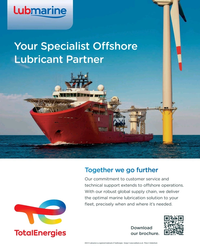 )
April 2024 - Maritime Reporter and Engineering News page: 3rd Cover
)
April 2024 - Maritime Reporter and Engineering News page: 3rd CoverYour Specialist Ofshore Lubricant Partner T Togeth her w we go o furt ther r Our commitment to customer service and technical support extends to ofshore operations. With our robust global supply chain, we deliver the optimal marine lubrication solution to your ?eet, precisely when and where it’s needed.
-
 )
April 2024 - Maritime Reporter and Engineering News page: 48
)
April 2024 - Maritime Reporter and Engineering News page: 48Index page MR Apr2024:MN INDEX PAGE 4/5/2024 1:33 PM Page 1 ANCHORS & CHAINS MILITARY SONAR SYSTEMS tel:+44 (0) 1752 723330, [email protected] , www.siliconsensing.com Anchor Marine & Supply, INC., 6545 Lindbergh Houston, Massa Products Corporation, 280 Lincoln Street, SONAR TRANSDUCERS
-
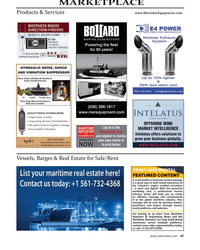 )
April 2024 - Maritime Reporter and Engineering News page: 47
)
April 2024 - Maritime Reporter and Engineering News page: 47MARKETPLACE Products & Services www.MaritimeEquipment.com Powering the fleet for 60 years! HYDRAULIC NOISE, SHOCK AND VIBRATION SUPPRESSOR Noise, Shock, VibraO on & PulsaO on in Quiet, Smooth Flow Out Oil Bladder Nitrogen (blue) Manufactured by MER
-
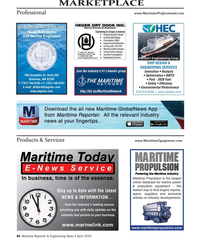 )
April 2024 - Maritime Reporter and Engineering News page: 46
)
April 2024 - Maritime Reporter and Engineering News page: 46MARKETPLACE Professional www.MaritimeProfessional.com GILBERT ASSOCIATES, INC.GILBERT ASSOCIATES, INC. Naval Architects and Marine Engineers SHIP DESIGN & ENGINEERING SERVICES Join the industry’s #1 Linkedin group )NNOVATION
-
 )
April 2024 - Maritime Reporter and Engineering News page: 43
)
April 2024 - Maritime Reporter and Engineering News page: 43“The industry is an ecosystem which includes owners, managers, mariners, shipyards, equipment makers, designers, research institutes and class societies: all of them are crucial,” – Eero Lehtovaara, Head of Regulatory & Public Affairs, ABB Marine & Ports All images courtesy ABB Marine and Ports provi
-
 )
April 2024 - Maritime Reporter and Engineering News page: 38
)
April 2024 - Maritime Reporter and Engineering News page: 38Tech Files Latest Products, Systems and Ship Designs Zero-Emission Mooring Service of a Tanker Consulmar achieved a milestone by executing what it calls ing boat Castalia, which operates on full electric propulsion. the world's ? rst zero-emissions mooring service for a tanker. Equipped with two 150 kW
-
 )
April 2024 - Maritime Reporter and Engineering News page: 28
)
April 2024 - Maritime Reporter and Engineering News page: 28FEATURE INTERVIEW track missiles and warheads for the Mis- sile Defense Agency, and it travels with its support ship, the MV Hercules. For our Service Support ships, we have the two hospital ships, USNS Mer- cy and Comfort; two rescue and salvage ships; two submarine tenders; and the Sixth Fleet ?
-
 )
April 2024 - Maritime Reporter and Engineering News page: 27
)
April 2024 - Maritime Reporter and Engineering News page: 27RADM PHILIP SOBECK, MILITARY SEALIFT COMMAND With COVID, we had to make some hard choices for our Do your CIVMARs have upward mobility? mariners because we couldn’t rotate. Many of our mariners The Navy has Sailors who become “Mustangs,” and work found other employment, and were able to use their skills
-
 )
April 2024 - Maritime Reporter and Engineering News page: 25
)
April 2024 - Maritime Reporter and Engineering News page: 25RADM PHILIP SOBECK, MILITARY SEALIFT COMMAND Photo by Brian Suriani USN Military Sealift Command From a global supply chain perspective, What makes MSC so vital to the we’ve learned a lot about dealing with Navy’s ? eet and our military disruptions. COVID delivered a big forces around the world? wake-up
-
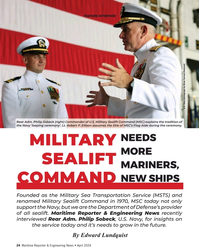 )
April 2024 - Maritime Reporter and Engineering News page: 24
)
April 2024 - Maritime Reporter and Engineering News page: 24FEATURE INTERVIEW U.S. Navy photograph by Brian Suriani/Released Rear Adm. Philip Sobeck (right) Commander of U.S. Military Sealift Command (MSC) explains the tradition of the Navy ‘looping ceremony’. Lt. Robert P. Ellison assumes the title of MSC’s Flag Aide during the ceremony. NEEDS MILITARY MORE
-
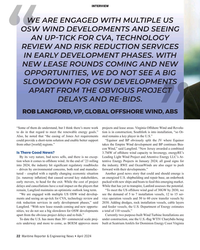 )
April 2024 - Maritime Reporter and Engineering News page: 22
)
April 2024 - Maritime Reporter and Engineering News page: 22INTERVIEW WE ARE ENGAGED WITH MULTIPLE US OSW WIND DEVELOPMENTS AND SEEING AN UP-TICK FOR CVA, TECHNOLOGY REVIEW AND RISK REDUCTION SERVICES IN EARLY DEVELOPMENT PHASES. WITH NEW LEASE ROUNDS COMING AND NEW OPPORTUNITIES, WE DO NOT SEE A BIG SLOWDOWN FOR OSW DEVELOPMENTS APART FROM THE OBVIOUS
-
 )
April 2024 - Maritime Reporter and Engineering News page: 21
)
April 2024 - Maritime Reporter and Engineering News page: 21ROB LANGFORD, VP, GLOBAL OFFSHORE WIND ob Langford has worked in the offshore industry ABS. “We are growing and evolving our services across all for more than three decades, ‘cutting his teeth’ offshore infrastructure along with our continued support to the in a UK design ? rm working in the North Sea
-
 )
April 2024 - Maritime Reporter and Engineering News page: 16
)
April 2024 - Maritime Reporter and Engineering News page: 16MARKETS SOVs – Analyzing Current, Future Demand Drivers By Philip Lewis, Director of Research, Intelatus © Björn Wylezich/AdobeStock t a high-level, there are three solutions to transferring Lower day rate CTVs are often used for daily transfer of technicians from shore bases to offshore wind farms
-
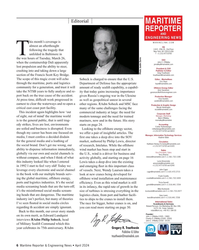 )
April 2024 - Maritime Reporter and Engineering News page: 6
)
April 2024 - Maritime Reporter and Engineering News page: 6Editorial MARITIME REPORTER AND ENGINEERING NEWS his month’s coverage is M A R I N E L I N K . C O M almost an afterthought HQ 118 E. 25th St., 2nd Floor following the tragedy that New York, NY 10010 USA T +1.212.477.6700 Tunfolded in Baltimore in the wee hours of Tuesday, March 26, CEO John C.
-
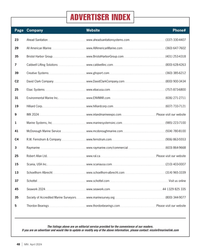 )
April 2024 - Marine News page: 48
)
April 2024 - Marine News page: 48ADVERTISER INDEX Page Company Website Phone# 23 Ahead Sanitation www.aheadsanitationsystems.com (337) 330-4407 29 All American Marine www.AllAmericanMarine.com (360) 647-7602 35 Bristol Harbor Group www.BristolHarborGroup.com (401) 253-4318 7 Caldwell Lifting Solutions www.caldwellinc.com (800)
-
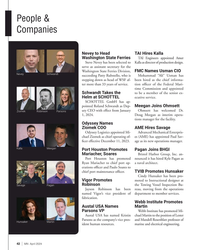 )
April 2024 - Marine News page: 42
)
April 2024 - Marine News page: 42People & Companies Nevey to Head TAI Hires Kalla Washington State Ferries TAI Engineers appointed Amer Steve Nevey has been selected to Kalla as director of production design. serve as assistant secretary for the FMC Names Usman CIO Washington State Ferries Division, Nevey Schwandt succeeding Patty
-
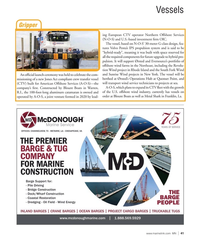 )
April 2024 - Marine News page: 41
)
April 2024 - Marine News page: 41Vessels Gripper ing European CTV operator Northern Offshore Services (N-O-S) and U.S.-based investment ? rm OIC. The vessel, based on N-O-S’ 30-meter G-class design, fea- tures Volvo Penta’s IPS propulsion system and is said to be “hybrid-ready”, meaning it was built with space reserved for all the
-
 )
April 2024 - Marine News page: 35
)
April 2024 - Marine News page: 35Capt. Josh Ferguson, master of the eWolf. Administration (MARAD), which all provided ? nancial support and other resources. “This tug becomes somewhat commercially viable be- cause of the grant process,” Manzi said. “Unlike a ferry service that’s paid for by tax dollars, we have to collect fares and
-
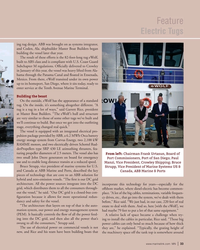 )
April 2024 - Marine News page: 33
)
April 2024 - Marine News page: 33Feature Electric Tugs ing tug design. ABB was brought on as systems integrator, and Coden, Ala. shipbuilder Master Boat Builders began building the vessel later that year. The result of these efforts is the 82-foot-long tug eWolf, built to ABS class and is compliant with U.S. Coast Guard Subchapter M
